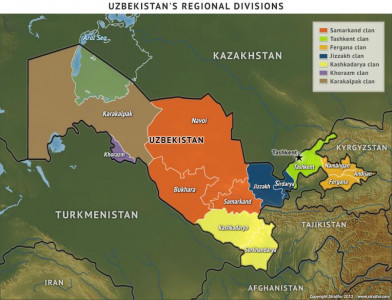The other day mass disturbances began in Uzbekistan. They were related to the right of autonomy for one of the country’s administrative units and the constitutional amendments published on June 25. The Uzbek parliament initially advocated amending the constitution and changing the administrative status of Karakalpakstan to make it an integral part of the country.
In the end, the Uzbek parliament left the old Constitution, and Karakalpakstan retained its status as an autonomous entity and the right to secede from the Uzbek Republic.
This issue is not at all new and existed during the Soviet period, although the territory has never actually seceded from Uzbekistan since then. Karakalpakstan was part of the Khorezm SSR, then the region was redistributed to Kyrgyzstan and even to the Kazakh ASSR. Thus, the region had already managed to wander from one country to another, but within the framework of a common union. After the collapse of the USSR, the issue of territorial boundaries in Central Asia became the most acute, because before this issue was settled by the supreme party leadership, but now it is done by the countries themselves. Since then, not a few supporters of the Karakalpak Republic have appeared. However, the republic never gained independence.
Karakalpakstan is for the most part a multi-ethnic region, not a mono-ethnic one, as most people assume. In addition to Karakalpaks, Uzbeks, Kazakhs, Koreans, and other ethnic groups also reside in the region. Karakalpakstan occupies 37 percent of Uzbekistan, but only about two million people live there, six percent of the population. Traditions, social orders, and beliefs are intertwined.
Over the past five years, about one billion dollars have been channeled into the budget of Karakalpakstan. Sixty-five thousand families have received material assistance. The GDP of the sovereign republic has tripled. The number of children in pre-schools increased from 32 percent to 75 percent. At the same time, Karakalpakstan is the poorest region of Uzbekistan. There are no reserves of water and minerals here. Most of the republic is a desert.
There are 5 articles in the Constitution concerning the territorial indivisibility of Uzbekistan. The most important in this case is the 70th article (on the sovereignty of the region) and the 74th article (on the right to secede from the country through a referendum). The lower chamber of the Uzbek parliament decided to retain these articles. Public discussion of the constitutional amendments has been extended until July 15.
Parliamentary discussions of the constitutional amendments sparked mass unrest. Uzbek President Shavkat Mirziyoyev visited the troubled region of Karakalpakstan, and rallies and protests were suppressed by law enforcement. However, Mirziyoyev tried to resolve the incident with the least consequences for both his regime and the people, thus finding a balance between the state and society. The president also expressed extreme dissatisfaction with the local authorities’ failure to notify the central authorities about the unrest and separatist sentiments.
Mirzoyev commented on the situation: “Why didn’t you call and say that people were not happy? I need the future of Karakalpakstan. Who needs to disgrace our work now? What is our goal? We must live freely. People should live freely regardless of nationality, religion, and language. Constitutional reform is being implemented to improve people’s lives. If the people of Karakalpakstan are dissatisfied, no article will ever change.
There are still discussions on social networks about the imperfection of constitutional reform. Opponents of the current government, who are affiliated with various outside organizations, mainly Turkish, have taken advantage of the flawed constitutional reform.
Protests in the country began as early as July 1 and then escalated into a mass march and widespread unrest. A group of protest organizers was detained, as was a group that was going to take over the local government. On 3 July, a state of emergency was declared in Karakalpakstan. On the same day, a court in Karakalpakstan opened several criminal cases for attempting to seize local authorities.
The Uzbek Interior Ministry released statistics a few days after the incident. According to the statistics, 516 people were detained, about 240 were injured and 18 were killed. According to other sources, 243 people were injured. There were also recorded cases of attacks on police officers and in an attempt to seize the Nukus airport, 38 security officers were injured. According to official data, the instigator of the rally was journalist and blogger Dauletmurat Tadzhimuratov, who posted a video message on social media calling for a rally in front of parliament. He was detained and protesters secured his release, but the unrest did not stop. The protesters managed to seize weapons at a military post in the Khojaly region and then attempted to seize the airport.
Now the situation in Karakalpakstan is calm and there are no demonstrations, although the curfew is still in effect. The Uzbek authorities assured the citizens that there was nothing to worry about, all their rights and freedoms were preserved, but in the event of renewed protests, the law enforcement authorities would give an even harsher response. In any case, there were no prospects for Karakalpakstan to gain independence. Economically, such a state would be completely unviable. And neighboring Kazakhstan and Turkmenistan will not wish to take responsibility for Nukus.
The very attempted revolution or local revolution is mostly a remnant of the velvet revolutions in Central Asia. The protests were fairly mild for Uzbekistan, and the use of force was minimal. The situation was resolved through the president’s gentle actions and the willingness of the authorities to listen to their people. However, when one looks at the region as a whole, instability is overwhelming, as in 2022 there were protests in Kyrgyzstan, Kazakhstan, and on the border of Uzbekistan and Tajikistan.
MORE ON THE TOPIC:






